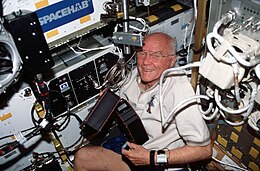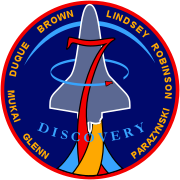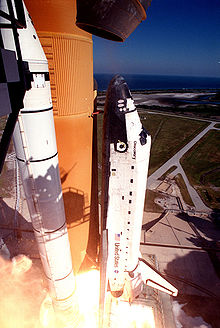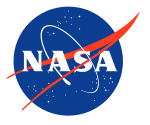
The Space Shuttle program was the fourth human spaceflight program carried out by the U.S. National Aeronautics and Space Administration (NASA), which accomplished routine transportation for Earth-to-orbit crew and cargo from 1981 to 2011. Its official name, Space Transportation System (STS), was taken from a 1969 plan for a system of reusable spacecraft of which it was the only item funded for development. It flew 135 missions and carried 355 astronauts from 16 countries, many on multiple trips.

Spacelab was a reusable laboratory developed by European Space Agency (ESA) and used on certain spaceflights flown by the Space Shuttle. The laboratory comprised multiple components, including a pressurized module, an unpressurized carrier, and other related hardware housed in the Shuttle's cargo bay. The components were arranged in various configurations to meet the needs of each spaceflight.

Marsha Sue Ivins is an American retired astronaut and a veteran of five Space Shuttle missions.

STS-51-G was the 18th flight of NASA's Space Shuttle program, and the fifth flight of Space Shuttle Discovery. The seven-day mission launched from Kennedy Space Center, Florida, on June 17, 1985, and landed at Edwards Air Force Base, California, on June 24, 1985. Sultan bin Salman Al Saud from Saudi Arabia was on board as a payload specialist; Al Saud became the first Arab, the first Muslim, and the first member of a royal family to fly into space. It was also the first Space Shuttle mission which flew without at least one astronaut from the pre-Shuttle era among its crew.

STS-41 was the 36th Space Shuttle mission and the eleventh mission of the Space Shuttle Discovery. The four-day mission had a primary objective of launching the Ulysses probe as part of the "International Solar Polar Mission" (ISPM).

STS-51 was a NASA Space Shuttle Discovery mission that launched the Advanced Communications Technology Satellite (ACTS) in September 1993. The flight also featured the deployment and retrieval of the SPAS-ORFEUS satellite and its IMAX camera, which captured spectacular footage of Discovery in space. A spacewalk was also performed during the mission to evaluate tools and techniques for the STS-61 Hubble Space Telescope (HST) servicing mission later that year. STS-51 was the first shuttle mission to fly a Global Positioning System (GPS) receiver, a Trimble TANS Quadrex. It was mounted in an overhead window where limited field of view (FoV) and signal attenuation from the glass severely impacted receiver performance. Full triple-redundant 3-string GPS would not happen until 14 years later with STS-118 in 2007.

Nancy Jan Davis is a former American astronaut. A veteran of three space flights, Davis logged over 673 hours in space. She is now retired from NASA.

Curtis Lee "Curt" Brown Jr. is a former NASA astronaut and retired United States Air Force colonel.

STS-60 was the first mission of the U.S./Russian Shuttle-Mir Program, which carried Sergei K. Krikalev, the first Russian cosmonaut to fly aboard a Space Shuttle. The mission used NASA Space Shuttle Discovery, which lifted off from Launch Pad 39A on February 3, 1994, from Kennedy Space Center, Florida. The mission carried the Wake Shield Facility experiment and a SPACEHAB module, developed by SPACEHAB Inc., into orbit, and carried out a live bi-directional audio and downlink link-up with the cosmonauts aboard the Russian space station Mir.
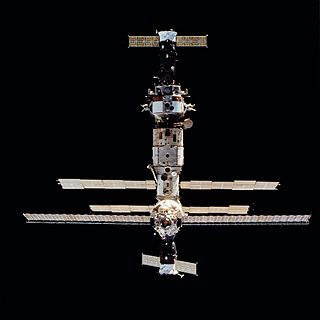
STS-63 was the second mission of the US/Russian Shuttle-Mir Program, which carried out the first rendezvous of the American Space Shuttle with Russia's space station Mir. Known as the 'Near-Mir' mission, the flight used Space Shuttle Discovery, which lifted off from launch pad 39B on February 3, 1995, from Kennedy Space Center, Florida. A night launch and the 20th mission for Discovery, it marked the first time a Space Shuttle mission had a female pilot, Eileen Collins, and the first EVAs for both a UK born astronaut, Michael Foale, and a US astronaut of African heritage, Bernard A. Harris, Jr. It also carried out the successful deployment and retrieval of the Spartan-204 platform, along with the scheduled rendezvous and flyaround of Mir, in preparation for STS-71, the first mission to dock with Mir.

STS-76 was NASA's 76th Space Shuttle mission, and the 16th mission for Atlantis. STS-76 launched on 22 March 1996 at 08:13:04 UTC from Kennedy Space Center, launch pad 39B. STS-76 lasted over 9 days, traveled about 6,100,000 km (3,800,000 mi) while orbiting Earth an estimated 145 times, and landing at 13:28:57 UTC on 31 March 1996 at Edwards Air Force Base, runway 22.

STS-79 was the 17th flight of Space Shuttle Atlantis, and the 79th mission of the Space Shuttle program. The flight saw Atlantis dock with the Russian space station Mir to deliver equipment, supplies and relief personnel. A variety of scientific experiments were also conducted aboard Atlantis by her crew. It was the first shuttle mission to rendezvous with a fully assembled Mir, and the fourth rendezvous of a shuttle to the space station.

STS-96 was a Space Shuttle mission to the International Space Station (ISS) flown by Space Shuttle Discovery, and the first shuttle flight to dock at the International Space Station. The shuttle carried the Spacehab module in the payload, filled with cargo for station outfitting. STS-96 launched from Kennedy Space Center, Florida, on 27 May 1999 at 06:49:42 AM EDT and returned to Kennedy on 6 June 1999, 2:02:43 AM EDT.

Nancy Jane Currie-Gregg is an American engineer, United States Army officer and a NASA astronaut. Currie-Gregg has served in the United States Army for over 22 years and holds the rank of colonel. With NASA, she has participated in four space shuttle missions: STS-57, STS-70, STS-88, and STS-109, accruing 1,000 hours in space. She currently holds an appointment as a professor of practice in the Department of Industrial & Systems Engineering at Texas A&M University.
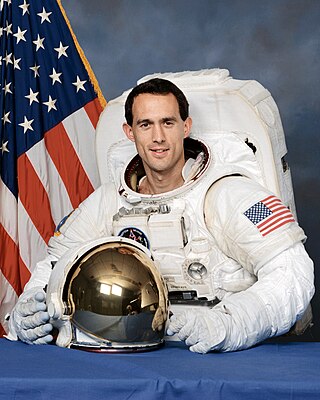
James Hansen Newman is an American physicist and a former NASA astronaut who flew on four Space Shuttle missions.

Soyuz TM-23 was a Soyuz spaceflight which launched on February 21, 1996, to Mir. The spacecraft launched from Baikonur Cosmodrome, and after two days of flight, Yuri Onufrienko and Yury Usachov docked with Mir and became the 21st resident crew of the Station. On September 2, 1996, after 191 days docked with Mir, the ship undocked with the launch crew and Claudie André-Deshays onboard, before eventually landing 107 km (66 mi) south west of Akmola, Kazakhstan.

The Shuttle–Mir program was a collaborative 11-mission space program between Russia and the United States that involved American Space Shuttles visiting the Russian space station Mir, Russian cosmonauts flying on the Shuttle, and an American astronaut flying aboard a Soyuz spacecraft to engage in long-duration expeditions aboard Mir.

STS-116 was a Space Shuttle mission to the International Space Station (ISS) flown by Space Shuttle Discovery. Discovery lifted off on December 9, 2006, at 20:47:35 EST. A previous launch attempt on December 7 had been canceled due to cloud cover. It was the first night launch of a Space Shuttle since STS-113 in November 2002.

NASA Astronaut Group 12 was a group of 15 astronauts announced by NASA on June 5, 1987.
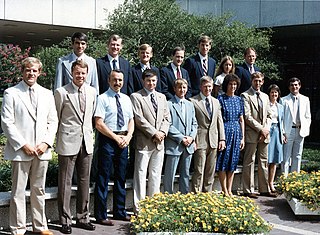
NASA Astronaut Group 10 was a group of 17 astronauts that were announced on May 23, 1984 and consisted of seven pilots and ten mission specialists. Although selected in 1984, no member of the group would fly until 1988 due to the Challenger disaster and the resulting grounding of the Space Shuttle fleet.
